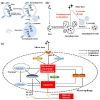Macrophage Autophagy and Silicosis: Current Perspective and Latest Insights
- PMID: 33466366
- PMCID: PMC7795780
- DOI: 10.3390/ijms22010453
Macrophage Autophagy and Silicosis: Current Perspective and Latest Insights
Abstract
Silicosis is an urgent public health problem in many countries. Alveolar macrophage (AM) plays an important role in silicosis progression. Autophagy is a balanced mechanism for regulating the cycle of synthesis and degradation of cellular components. Our previous study has shown that silica engulfment results in lysosomal rupture, which may lead to the accumulation of autophagosomes in AMs of human silicosis. The excessive accumulation of autophagosomes may lead to apoptosis in AMs. Herein, we addressed some assumptions concerning the complex function of autophagy-related proteins on the silicosis pathogenesis. We also recapped the molecular mechanism of several critical proteins targeting macrophage autophagy in the process of silicosis fibrosis. Furthermore, we summarized several exogenous chemicals that may cause an aggravation or alleviation for silica-induced pulmonary fibrosis by regulating AM autophagy. For example, lipopolysaccharides or nicotine may have a detrimental effect combined together with silica dust via exacerbating the blockade of AM autophagic degradation. Simultaneously, some natural product ingredients such as atractylenolide III, dioscin, or trehalose may be the potential AM autophagy regulators, protecting against silicosis fibrosis. In conclusion, the deeper molecular mechanism of these autophagy targets should be explored in order to provide feasible clues for silicosis therapy in the clinical setting.
Keywords: alveolar macrophage; autophagy; silicosis.
Conflict of interest statement
The authors declare no conflict of interest.
Figures


References
-
- Gaida A., Piasco D. The Diffuse Interstitial Fibrosis Component of Pulmonary Silicosis. Minerva Med. 1963;54:1856–1861. - PubMed
-
- Pavan C., Santalucia R., Leinardi R., Fabbiani M., Yakoub Y., Uwambayinema F., Ugliengo P., Tomatis M., Martra G., Turci F., et al. Nearly Free Surface Silanols Are the Critical Molecular Moieties That Initiate the Toxicity of Silica Particles. Proc. Natl. Acad. Sci. USA. 2020;117:27836–27846. doi: 10.1073/pnas.2008006117. - DOI - PMC - PubMed
-
- Pavan C., Delle Piane M., Gullo M., Filippi F., Fubini B., Hoet P., Horwell C.J., Huaux F., Lison D., Lo Giudice C., et al. The Puzzling Issue of Silica Toxicity: Are Silanols Bridging the Gaps between Surface States and Pathogenicity? Part. Fibre Toxicol. 2019;16:32. doi: 10.1186/s12989-019-0315-3. - DOI - PMC - PubMed
-
- Nagelschmidt G., Nelson E.S., King E.J., Attygalle D., Yoganathan M. The Recovery of Quartz and Other Minerals from the Lungs of Rats; A Study in Experimental Silicosis. AMA Arch. Ind. Health. 1957;16:188–202. - PubMed
Publication types
MeSH terms
Grants and funding
LinkOut - more resources
Full Text Sources
Other Literature Sources

